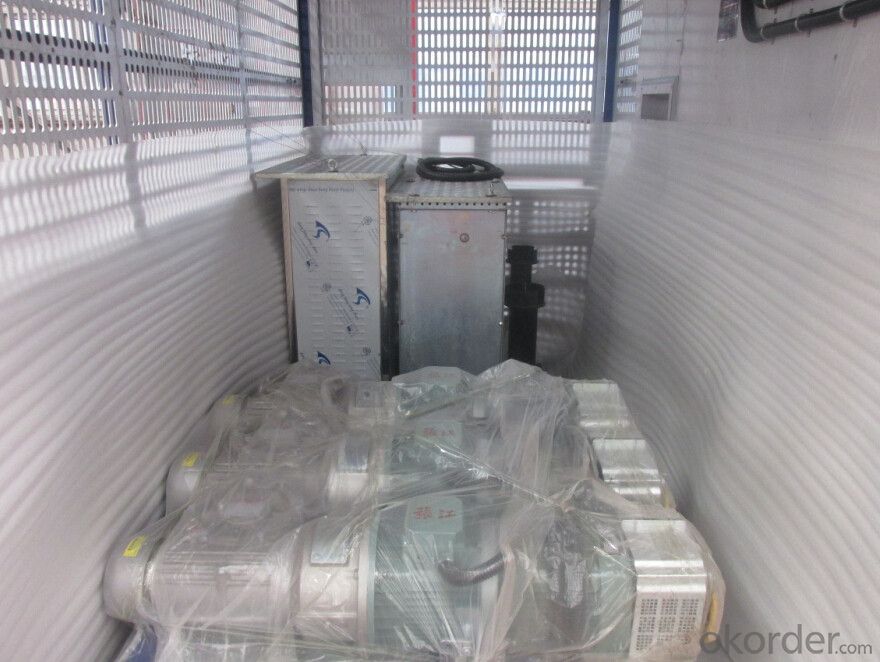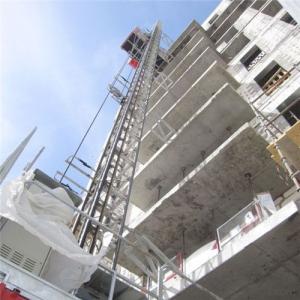Building Hoist SC120 Middle Speed Frequncy Speed
- Loading Port:
- China main port
- Payment Terms:
- TT OR LC
- Min Order Qty:
- 1 unit
- Supply Capability:
- 30 unit/month
OKorder Service Pledge
OKorder Financial Service
You Might Also Like
Specification
Building Hoist Description
Condition: New
Application: Construction
Payload(kg):1200
Lifting Speed(m/min):0~60
Motor Power(kw): 3*11
Safety Device: SAJ30-1.4
Cage: Single
Counterweight: No
Certification: CE,ISO
Place of Origin: China(Mainland)
Model Number: Type:SC120
Packaging & Delivery of Building Hoist
Packaging Detail: Nude package
Delivery Detail: 25-30days
Features of Building Hoist
●Due to the strict raw material procurement control system, our drive motors for construction hoist/ building lift /material elevator for bridge/ tower / chimney / building is guaranteed with safe and reliable performance.
●The steel, electrical components, hoist cables, high strength bolts and spare parts are all introduced from well-known international and domestic suppliers.
●Adopts the most advanced VF speed control device and microcomputer programmable logic controller.
● Stepless speed control helps eliminate the concussion during start up and braking, steady the operation process,
and ensures automated leveling.
● Adopts open loop V/Fcontrol; the speed control precision can reach ±2~3%. Realizes accurate low speed positioning of the hoist and avoid slipping during downward stopping of hoist.
● The VF system has current-restriction function, ensuring a small current when motor start up and reducing the concussion to power supply. It reduces the engery consumption and mitigates effects to on site electric equipments.
Building Hoist Images



Building Hoist Specifiction

FAQ of Building Hoist
Q: What is the building hoist main purpose?
A: Building hoist equipped with double or single cabin to transport the materials and labors up and down. It's the ideal
construction equipment for vertical transportation in the field of construction.
Q: What is the main structure of building hoist?
A: The P/M construction hoist mainly contains metal structure, driving system, electrical control system, cable guide &
protection system, electrical top crane and safety device.
Q: What is the meaning of the building hoist’s code?
A: Take SC200/200 for example: “SC” stands for rack and pinion hoist, “200/200” stands for double cage and capacity
is 2 tons per cage. “SC200” stands for single cage and capacity is 2 tons.
- Q: This question asks for the method to adjust the tension of ropes or cables in lifting equipment such as a building hoist.
- <p>Adjusting the tension on ropes or cables in lifting equipment like a building hoist involves several steps. First, ensure the equipment is turned off and secured to prevent any accidents. Then, locate the tensioning mechanism, which could be a ratchet, turnbuckle, or a similar device. Gradually adjust the mechanism to tighten or loosen the cable as needed. Use a tension meter to measure the tension and ensure it meets the manufacturer's specifications. Regularly inspect the cables for wear and damage, and replace them if necessary. Always follow the equipment's manual for specific instructions and safety guidelines.</p>
- Q: Is it possible to utilize a building hoist for the purpose of lifting heavy equipment or machinery?
- <p>Yes, a building hoist can be used for lifting heavy equipment or machinery, provided it has the necessary capacity and safety features. These hoists are designed to handle substantial loads and are commonly used in construction for moving materials and equipment. However, it's crucial to ensure that the hoist is rated for the weight of the equipment, and all safety protocols are followed to prevent accidents. Regular maintenance and inspection are also essential to ensure the hoist's reliability and safety during heavy lifting operations.</p>
- Q: This question asks for the methods used to maintain and care for a building hoist, which is a type of lifting equipment used in construction.
- <p>Regular maintenance of a building hoist is crucial for safety and efficiency. Key methods include daily inspections of cables, hooks, and safety devices for any signs of wear or damage. Lubricate moving parts as per the manufacturer's guidelines to reduce friction and prevent rust. Ensure that all electrical components are clean and dry, and check for any loose connections or damaged wires. Perform load tests periodically to confirm the hoist's lifting capacity and safety. Keep the control panel and all operational areas clean and free from debris. Regularly check the hoist's anchorage to ensure it is secure. Adhere to all manufacturer's recommendations for maintenance intervals and procedures. Proper maintenance can extend the life of the hoist and prevent accidents.</p>
- Q: This question asks for a comparison between electric and hydraulic building hoists, highlighting their main differences.
- <p>Electric building hoists are powered by electricity and use electric motors to lift and lower loads. They are generally quieter, require less maintenance, and can be more energy-efficient. Hydraulic building hoists, on the other hand, use hydraulic pressure to move loads. They tend to be more powerful and can lift heavier loads, but they may require more maintenance and are not as energy-efficient. Electric hoists are often preferred for lighter loads and indoor use, while hydraulic hoists are chosen for heavy-duty applications and outdoor use where power is not readily available.</p>
- Q: This question asks for safety precautions that should be taken when using a building hoist, which is a type of lifting equipment used in construction.
- <p>Safety measures for using a building hoist include regular inspections and maintenance, ensuring all safety devices are in good working order, securing all loads properly, and not overloading the hoist. Operators must be trained and certified. Protective barriers should be in place to prevent unauthorized access. Emergency stop switches should be readily accessible. Workers should wear appropriate personal protective equipment, and communication between the hoist operator and those on the ground should be clear and effective. Adhering to these measures helps prevent accidents and ensures the safe operation of the building hoist.</p>
- Q: Is it possible to use a lifting device to lift objects that are heavier than its specified maximum load?
- <p>No, a lifting device should never be used to lift objects that exceed its rated load capacity. Doing so can lead to catastrophic failure of the device, potentially causing serious injury or death. Always adhere to the manufacturer's specifications to ensure safety and prevent accidents. Overloading a lifting device can result in structural damage, compromised safety mechanisms, and increased risk of collapse or dropping the load. It is crucial to respect the load limits to maintain the integrity and reliability of the lifting equipment.</p>
- Q: Describe the process of utilizing a computer control system for operating a building hoist.
- <p>To use a computer control system for a building hoist, first ensure the system is properly installed and integrated with the hoist's mechanical and electrical components. Begin by powering on the control system and checking for any error messages that might indicate a problem. Once the system is ready, input the desired parameters such as load weight, lifting height, and speed settings. Use the control panel to initiate the hoist's movement, monitoring the progress on the system's display. Adjust the hoist's operation in real-time as needed, ensuring safety protocols are followed. Regularly check system diagnostics for maintenance alerts and address any issues promptly to maintain optimal performance.</p>
- Q: When building tall buildings, the machine that USES to lift concrete to wait for tall building
- It should be the ground pump, the center is the tower crane, the construction face is the concrete pump of the cloth machine to the construction method. The advanced cloth machine is the arm bracket of the pump car, can operate with the remote control, is as convenient as the pump car.
- Q: What are the necessary steps and checks required to maintain a building hoist to ensure its safe and efficient operation?
- <p>Building hoists require regular maintenance to ensure safety and efficiency. This includes daily inspections of the hoist's mechanical and electrical components for any signs of wear or damage. Monthly, a thorough inspection should be conducted by a qualified technician, including checking the hoist's cables, brakes, and safety devices. Lubrication of moving parts and replacement of worn components are also crucial. Annually, a comprehensive inspection and certification by a professional is necessary to comply with safety regulations. Adherence to the manufacturer's guidelines is essential, and any malfunctions should be addressed immediately to prevent accidents.</p>
- Q: This question asks if it is permissible to use a building hoist for the purpose of lifting people.
- <p>No, a building hoist should not be used for lifting people. Building hoists are designed for the transportation of materials and equipment during construction, not for carrying personnel. Using a building hoist to lift people is dangerous and against safety regulations. It poses significant risks, including falls and equipment malfunctions, which can lead to serious injuries or fatalities. Always use designated personnel lifts or other safe methods for moving people in construction settings.</p>
Send your message to us
Building Hoist SC120 Middle Speed Frequncy Speed
- Loading Port:
- China main port
- Payment Terms:
- TT OR LC
- Min Order Qty:
- 1 unit
- Supply Capability:
- 30 unit/month
OKorder Service Pledge
OKorder Financial Service
Similar products
Hot products
Hot Searches
Related keywords


































